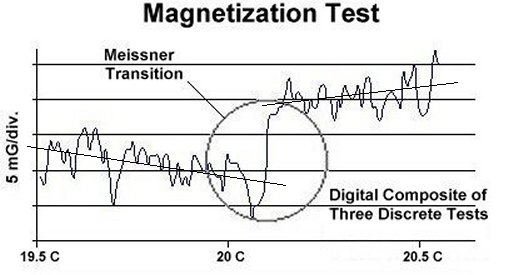

Superconductors.ORG herein reports the observation of superconductivity near 20 C.
In eight magnetization tests a small amount of the compound (Tl5Pb2)Ba2MgCu10O20+ consistently produced sharp diamagnetic transitions (the Meissner effect) near 20 Celsius (see above graphic), and resistive transitions that appeared near 18.5C (see below right). These temperatures are believed accurate +/- 2 degrees.
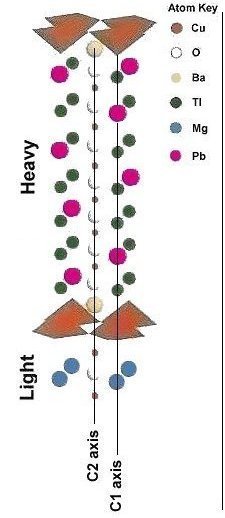
|
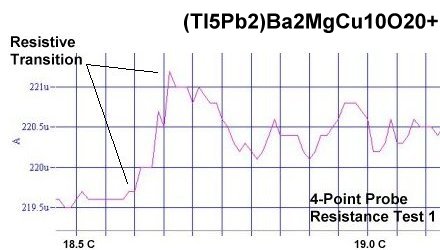 Resistance-v-temperature tests of this material were performed using a 4-point probe. Four significant bits of data resolution were necessary to resolve the 18.5C critical transition temperature (Tc) due to a low signal-to-noise ratio (S/N). A sharp transition appeared across just 1.5 uA of a 220 uA signal. This suggests a superconductive volume fraction less than 1% of the bulk. This extraordinarily high Tc was achieved by engineering a theoretical D223 structure (where D hex=13 dec) that pushes the limit of the longest C-axis lattice that will superconduct, while simultaneously establishing near-optimum Pb-doping of the Tl-Cu-O blocking layers (see structure at left). |
In 2008 a Sn-In-Pb-Tm cuprate produced superconductivity near
195K . That material had a C-axis lattice constant around 33 angstroms.
Attempts to go beyond 33 Å within that system failed to produce signs of superconductivity.
That fact pointed to 33 Å being a rough upper size limit for a superconductive unit cell
within this family of copper perovskites. Since the 3 Celsius superconductor discovered in December 2010,
had a C axis length under 28 Å, the next attempt to advance high Tc focused on increasing the unit cell parameters.
The first material attempted was (Tl5Pb)Ba2MgCu9O18+ which had a C axis length near 30 Å, but a reduced percentage of Pb doping - around 16%, sted 20% (see below 7C graphic). (Tl5Pb)Ba2MgCu9O18+ displayed a magnetic Tc near 9C (282K) and resistive Tc near 7C (280K). This was an improvement. However, within its magnetization plot were signs of still higher superconductivity being generated by a minority phase. (Tl5Pb2)Ba2MgCu10O20+, with a unit cell near 32.7 Å, was then synthesized, displaying an unambiguous diamagnetic transition near 20 Celsius.
These 18C and 7C structures are shown below alongside the previous world record holders for comparison.
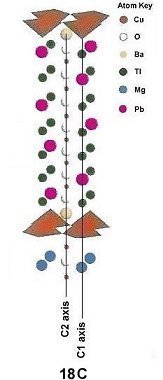
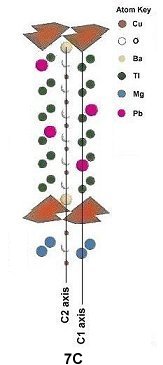
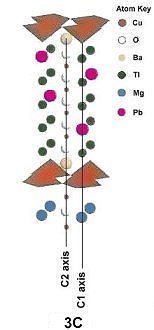
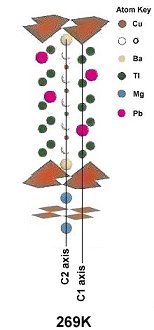
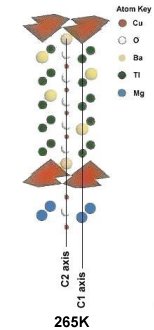
With two atoms of divalent Pb, the insulating layer of the 18C superconductor is hole-doped 28.5%. This increased doping level approaches the optimum of 25% discovered empirically within the Sn-In-Pb copper-oxide family in 2008. Additionally, 28.5% is near a 30% optimum level for Pb-doping found by Shao, et al, in 1995(1).
Dots have been placed within the C1 plot below, depicting where D223(Tl5Pb2-Mg) and B223(Tl5Pb-Mg) lie relative to the other high performance thallium-cuprates. Temperatures plotted (in Kelvin) are resistive. The correlation between planar weight ratio and Tc is unmistakable.
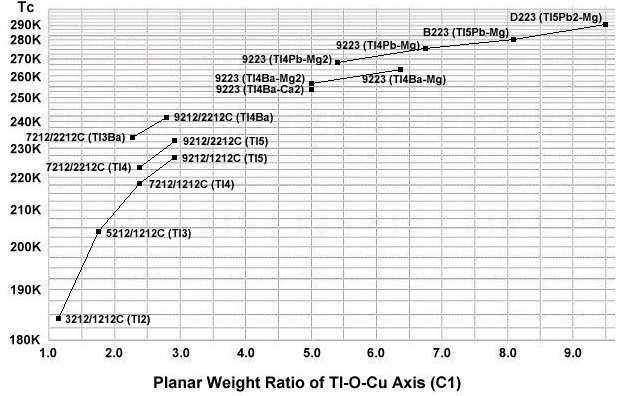
As with prior discoveries that advanced high Tc through asymmetry along the C axis, this material does not form stoichiometrically (by conventional mixing of chemicals). It must be synthesized using the layer cake method, as shown below. The prototype pellets each had roughly 20 to 22 layers. And, even using this technique, the volume fraction is low. Thus, commercialization will have to wait for a refinement method to be developed.
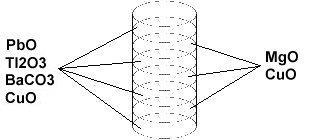
This discovery is being released into the public domain without patent protection in order to encourage additional research. Synthesis was by the solid state reaction method.
The below stoichiometric ratios were used for the ODD layers:
PbO 99.99% (Alfa Aesar) 2.88 grains...and the below ratios for the EVEN layers.
MgO 99.95% (Alfa Aesar) 1.04 grains (4x stoichiometric)The chemical precursors were pelletized at 70,000 PSI and sintered for 35-36 hours at 865C. The pellet was then annealed for 10 hours at 500C in flowing O2. The magnetometer employed twin Honeywell SS94A1F Hall-effect sensors with a tandem sensitivity of 50 mv/gauss. The 4-point probe was bonded to the pellet with CW2400 silver epoxy and used 7 volts on the primary. Temperature was determined using an Omega type "T" thermocouple and precision OP77 DC amplifier.
RESEARCH NOTE: The copper-oxides are strongly hygroscopic. All tests should be performed immediately after annealing.
E. Joe Eck
© 2011 Superconductors.ORG
All rights reserved.
1. The Synthesis and Characterization of HgBa2Ca2Cu3O8+ Superconductors with Substitution of Hg by Pb, by H.M. Shao, C.C. Lam, P.C.W. Fung,
X.S. Wu, J.H. Du, G.J. Shen, J.C.L. Chow, S.L. Ho, K.C. Hung, and X.X. Yao, Physica C Volume: 246, 1995 Page(s): 207-215
 BACK to "News" page at Superconductors.ORG
BACK to "News" page at Superconductors.ORG